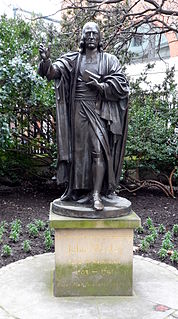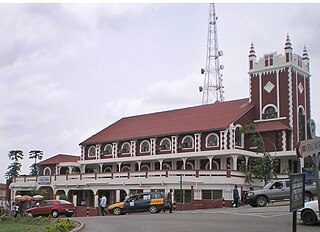
Methodism, also known as the Methodist movement, is a group of historically related denominations of Protestant Christianity which derive their practice and belief from the life and teachings of John Wesley. George Whitefield and John's brother Charles Wesley were also significant early leaders in the movement. It originated as a revival movement within the 18th-century Church of England and became a separate denomination after Wesley's death. The movement spread throughout the British Empire, the United States, and beyond because of vigorous missionary work, today claiming approximately 80 million adherents worldwide.
The United Methodist Church (UMC) is a mainline Protestant denomination and a major part of Methodism. In the 19th century, its main predecessor, the Methodist Episcopal Church, was a leader in evangelicalism. The present denomination was founded in 1968 in Dallas, Texas, by union of The Methodist Church and the Evangelical United Brethren Church. The UMC traces its roots back to the revival movement of John and Charles Wesley in England, as well as the Great Awakening in the United States. As such, the church's theological orientation is decidedly Wesleyan. It embraces liturgical, holiness, and evangelical elements.

John Wesley was an English cleric, theologian and evangelist who was a leader of a revival movement within the Church of England known as Methodism. The societies he founded became the dominant form of the independent Methodist movement that continues to present.

Francis Asbury was one of the first two bishops of the Methodist Episcopal Church in the United States. As a young man in October 1771, the Englishman traveled to America. During his 45 years in the colonies and the newly independent United States, he devoted his life to ministry, traveling on horseback and by carriage thousands of miles to those living on the frontier.

The Wesley Covenant Service was adapted by John Wesley, the founder of Methodism, for use in services for the Renewal of the believer's Covenant with God. In his Short history of the people called Methodists, Wesley describes the first covenant service; a similar account is to be found in his Journal of the time. Wesley says that the first service was held on Monday 11 August 1755, at the French church at Spitalfields in London, with 1800 people present. He reports that he "recited the tenor of the covenant proposed, in the words of that blessed man, Richard Alleine".
Albert Cook Outler was a 20th-century American Methodist theologian and philosopher. Outler is generally considered to be one of the most important Wesley scholars in the history of the church as well as the first real United Methodist theologian. He was also a key figure in the 20th-century ecumenical movement.

The Wesleyan Quadrilateral, or Methodist Quadrilateral, is a methodology for theological reflection that is credited to John Wesley, leader of the Methodist movement in the late 18th Century. The term itself was coined by 20th century American Methodist scholar Albert C. Outler.
The Methodist Church of Great Britain is a Protestant Christian denomination in Britain and the mother church to Methodists worldwide. It participates in the World Methodist Council, the World Council of Churches and other ecumenical associations.

George Lavington was a Bishop of Exeter from 1746 to 1762.
A watchnight service is a late-night Christian church service. In many different Christian traditions, such as those of Moravians, Baptists, Methodists, Anglicans and Pentecostals, watchnight services are held late on New Year's Eve. This provides the opportunity for Christians to review the year that has passed and make confession, and then prepare for the year ahead by praying and resolving. The services often include singing, praying, exhorting, and preaching.

Wesleyan theology, otherwise known as Wesleyan–Arminian theology, or Methodist theology, is a theological tradition in Protestant Christianity that emphasizes the "methods" of the eighteenth-century evangelical reformers John Wesley and his brother Charles Wesley. More broadly, it refers to the theological system inferred from the various sermons, theological treatises, letters, journals, diaries, hymns, and other spiritual writings of the Wesleys and their contemporary coadjutors such as John William Fletcher.
The Diocese of Karimnagar is a diocese of Church of South India in Telangana state of India.The diocese is one among the 22 dioceses of Church of South India.

The Wesleyan Methodist Church was the name used by the majority Methodist movement in Great Britain following its split from the Church of England after the death of John Wesley and the appearance of parallel Methodist movements. The word Wesleyan was added to the title to differentiate it from the Welsh Calvinistic Methodists, founded by George Whitefield who, like Wesley and his brother Charles, had been a member of the Holy Club in Oxford to which the epithet Methodist was first applied, and from the Primitive Methodist movement, which separated from the Wesleyans in 1807. The Wesleyan Methodist Church followed the Wesleys in holding to an Arminian theology, as against Whitefield's Calvinism; its Conference was also the legal successor to John Wesley as holder of the property of the original Methodist Societies.

St. Andrew's Wesley Church is a church located in downtown Vancouver, British Columbia, Canada. The church was designed by Twizel and Twizel and is constructed from Nelson Island granite and Haddington Island stone.

The Methodist Church of Sri Lanka and in is a Protestant Christian denomination in Sri Lanka. Its Headquarters is in Colombo and was established on 29 June 1814. It is a member of the World Council of Churches, the Christian Conference of Asia, the National Christian Council of Sri Lanka and the World Methodist Council.

The statue of John Wesley, St Paul's Churchyard is an outdoor bronze sculpture depicting the theologian, cleric and co-founder of the religious movement known as Methodism, John Wesley. The statue is located northwest corner of St Paul's Churchyard, London, England, and was erected in 1988. It was cast from a sculpture created by Samuel Manning and his son between 1825 and 1849.

The Sunday Service of the Methodists, with The Sunday Service of the Methodists; With Other Occasional Services being the full title, is the first Christian liturgical book given to the Methodist Churches by their founder, John Wesley. It has its basis in the 1662 Book of Common Prayer. Editions were produced for Methodists in both the British Empire and in North America.









